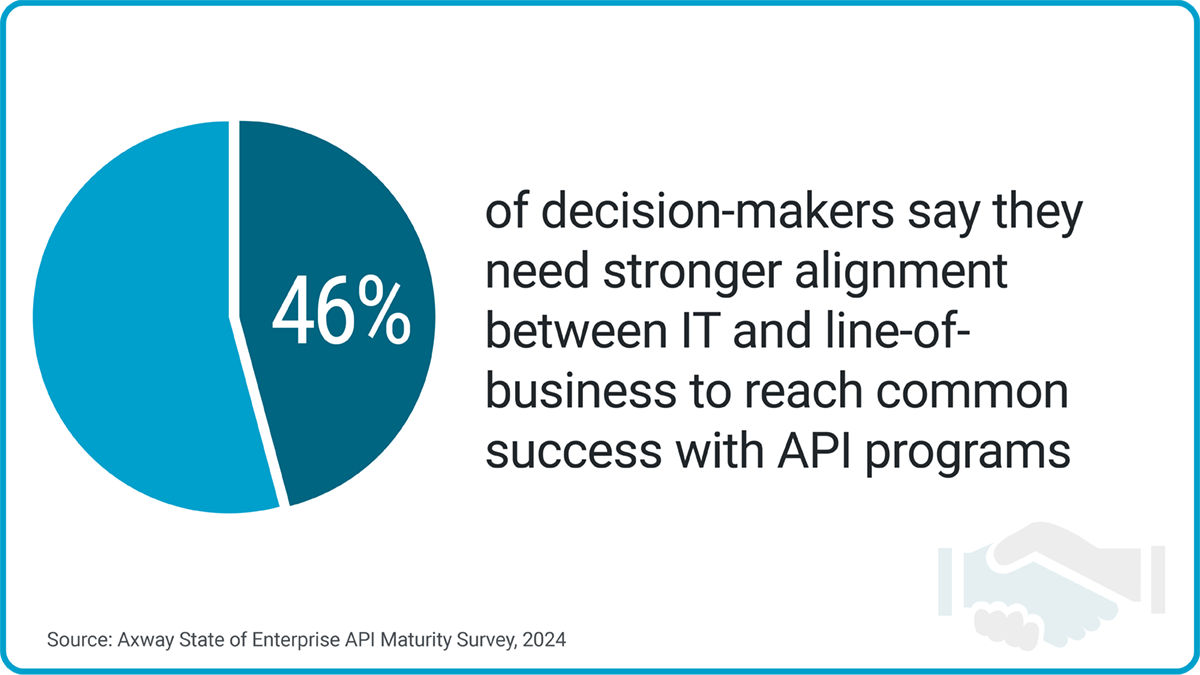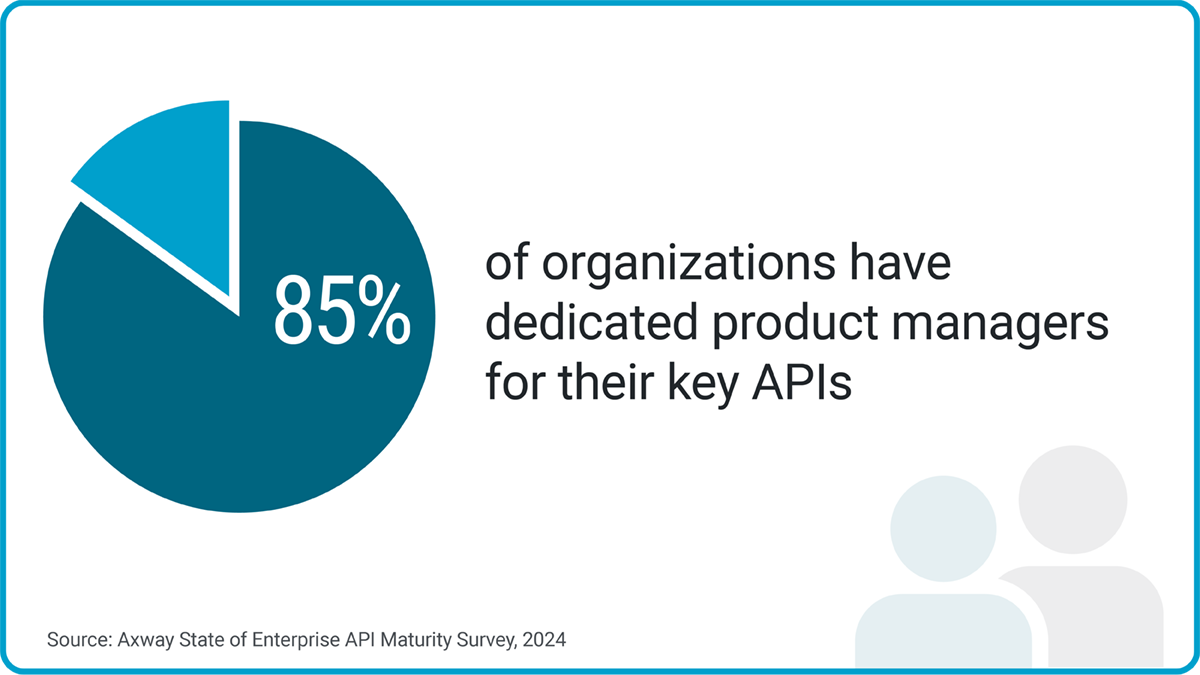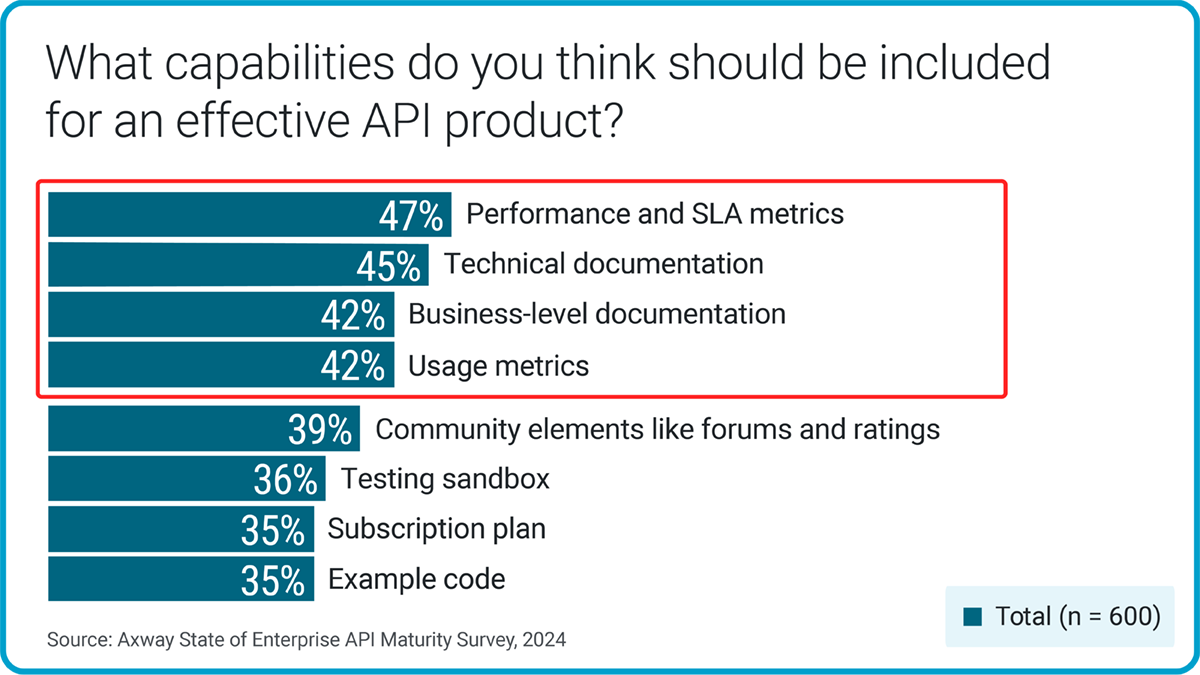“API products” are mentioned relatively often, and there are different ways to look at the topic. None of them is inherently “right” or “wrong”, and we’ll discuss the two most important flavors of API products in this blog post. Here’s our preferred definition:
An API product is a business-focused digital capability that is packaged and exposed as an API, whether for internal or external consumption. It is the broader and more inclusive way of understanding the role of APIs in an organization’s digital transformation, beyond just externally-facing APIs.
Whenever you have conversations about API products, it can be helpful to make sure that everybody is talking about the same thing: after all, finding the right alignment is a key concern in enterprises’ API strategy!

The most important takeaway of this blog post may be to not conflate the term “API Product” with APIs that are specifically marketed and monetized as externally provided products. (More on this below.)
Much more often, API products will be parts of a bigger value chain picture, and in those scenarios it is equally important to understand what it takes to create and manage API products.
What is an API product?
Looking at how the term “API Product” is commonly used, two main uses can be identified. We’ll start with the narrower definition (“API as a Product”) and then extend this to the more general understanding of what an API product is.
In our experience, it is much more helpful to use the more general understanding, because otherwise you will lose out on all the benefits that come with approaching all business-relevant APIs with a product mindset.
Dive deeper into understanding API productization
Watch the video below for an overview of this approach to API strategy by Axway VP Catalysts, Brian Otten. He covers the definition of an API Product and discusses its role in a successful API strategy.
API-as-a-Product
In a narrow sense, there’s the idea of managing an API as a product in and of itself. That’s something that’s tantalizingly easy to understand, but sadly also only makes sense for a thin slice of API use cases in the real world. An API-as-a-Product example would be Twilio and Stripe, where your API is the product you’re selling; and some companies have become very successful doing it.
There’s nothing wrong with that view, but it does not accurately capture the reality of the overwhelming number of organizations on their API journey. Very few of them have the intention of marketing APIs as their main products, which means that approaching API products with that narrow mindset misses the reality of the majority of organizations.
For this reason, we propose to use the term “API product” in a more inclusive way: the goal isn’t to just look at externally-exposed API products. Instead, you want to make sure that you’re treating all APIs that contribute to your organization’s business goals as products, and that you’re managing them accordingly.
Dive deeper into the distinctions between API product vs product API vs API as a product.
API products in general
The main value of APIs lies in their “packaging” nature: they wrap any digital building block in a way that make it usable for anybody interested in that capability. This “packaging” nature applies to any potential user of that digital building block.
The larger organizations become, the more it becomes important that they properly manage and provide all their capabilities for internal consumers. That’s the only way to make digital transformation work, which in its most simple definition demands that you transform your organization so that it can easily capture opportunities in the digital realm.
Jeff Bezos’ famous “API mandate” means, in essence, treating any capability as a product with an API, specifically also those that are not (yet) intended for external consumption. Limiting your product perspective to APIs intended for external consumption will forgo most of the benefits of APIs and will turn your organization into one that’s digital on the surface, but hasn’t quite taken the step towards true digital transformation.
What this means for our “API product” discussion is that you should approach all your business-level capabilities as API products. To be sure, this is a long journey, both in terms of building the skills and practices to manage API products, and in terms of slowly building up that catalog of API products that form the digital foundation of your organization.
But today we have more and more experience in how to do this: software solutions such as API marketplaces help you achieve this, and there is plenty of proof that doing it is a worthwhile investment in your organization’s future.
Decision-makers are taking note: Axway’s 2024 State of Enterprise API Maturity report found that a growing number of enterprises are building robust external ecosystems with their APIs, with 99.5% of organizations reporting that APIs are part of their go-to-market strategy.
These organizations are also doing more to treat APIs as products, designating API product managers (more on this below) and putting a strategy around them in place.
What really matters for API products
Now that we have established that a more general understanding of API products will get you further on your API journey, what really matters for API products? We don’t have enough space to discuss all the details here, but here are some areas that you should keep in mind:
- API product lifecycle. Like any other product, API products have a lifecycle. They are conceived and designed for a specific set of consumers, they need to evolve alongside the needs of these consumers, and they need to have a well-managed product lifecycle from inception to sunsetting.
- API product development. Product development always is an outside-in process, starting with the needs of a user group and following a design process to best serve the needs of that user group. This can be quite a shift from the inside-out mindset of many APIs that simply expose technical capabilities without thinking about the needs of consumers of that capability.
- API product owner. In order for the lifecycle to be managed, and in order for the development to maximize the usefulness of the API, API products should have product owners whose job it is to make sure that the API creates the most value for the organization and for its users.
Building an API product around business capabilities might mean bundling multiple technical interface APIs to support a business function, allowing you to create an API product that solves specific needs. An API as a Product strategy requires a mindset that considers people first.
This means asking yourself how consumers are going to use the APIs, then strategically linking APIs and wrapping up a value proposition, documentation, and subscription plans around the products you develop. In the above-mentioned API maturity survey, enterprise priorities for building API products reflect these elements:
API products need an API Product Manager
In the video below, Brian discusses the role of an API Product Manager and how they can help an organization make the cultural shift toward treating APIs as products.
This shift is already happening: the 2024 State of Enterprise API Maturity survey found that enterprise decision-makers understand the value of their digital assets and the importance of treating them as products.

Companies are adding API marketplaces to their API portals because they are a tool for the API Product Manager, helping them to deliver API products vs just technical capabilities. Read four more reasons they are adopting API marketplaces here.
This short explanation of the most useful way to think about what an “API product” is hopefully enough to get you started on your own API journey. To learn more about API products, the intention behind them, and what treating them as products means in practice, check out this conversation between Erik Wilde and renowned API expert Mike Amundsen about API products.
If APIs are products, it follows that they need to be exposed for consumption. Learn what an API marketplace can do for your business in our interactive eBook.



